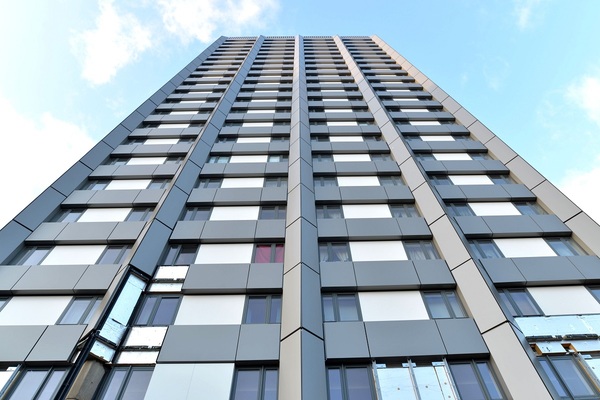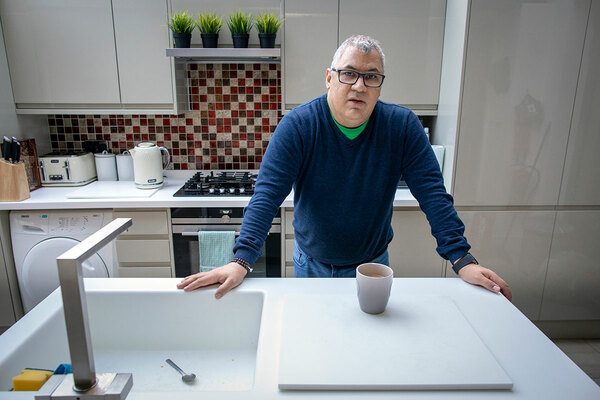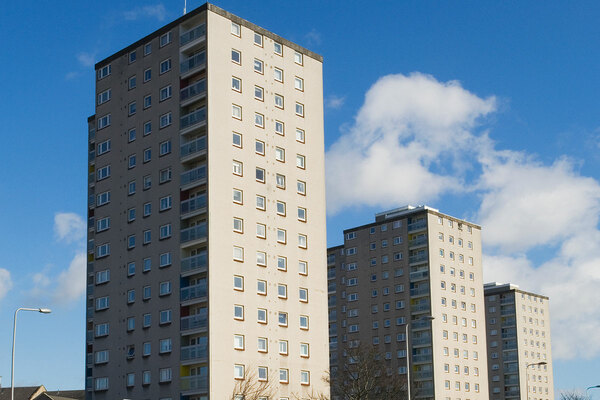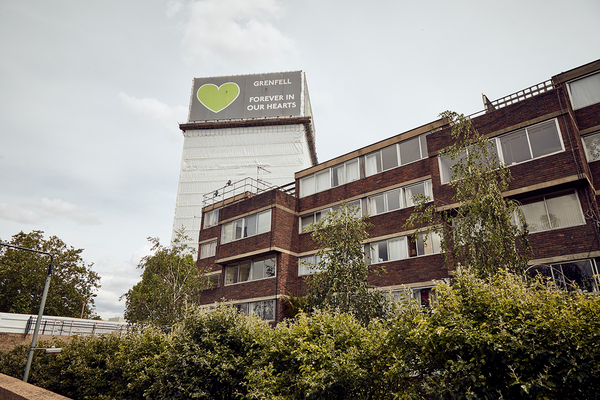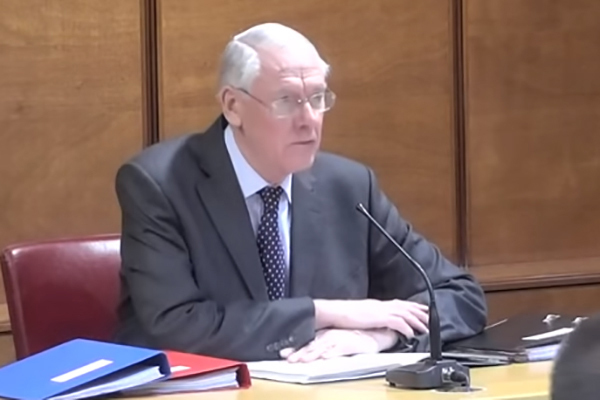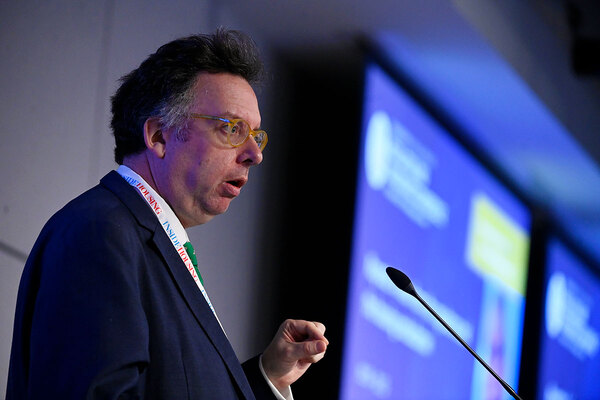Grenfell cladding manufacturer aware panels were ‘dangerous’ and below standard, inquiry hears
The manufacturer of the cladding panels used on Grenfell Tower was aware they had a low fire rating that made them “dangerous” for use on tall buildings, the inquiry into the fire heard this morning.
Explosive behind-the-scenes comments from cladding manufacturer Arconic were read out by a lawyer acting for contractor Rydon, appearing to show that senior members of the firm were aware that the panels were three grades below their advertised performance rating.
The panels, Reynobond PE 55, were described as the primary cause of the rapid spread of the blaze up the building in chair Sir Martin Moore-Bick’s first phase report in October.
The company had provided a certificate from the British Board of Agrément (BBA) that assured the panels were ‘Euroclass B’ – the minimum grade required for compliance with UK guidance.
But this certificate did not distinguish between the panels as they are normally cut or those in their “cassette form” – a specific way of producing them that reduced fire performance. These were the type used on Grenfell Tower.
“The BBA certificate is an important document as it is intended to be and is relied upon by construction professionals, as it was in the case of the Grenfell Tower refurbishment project, to contain accurate statements and information,” said Marcus Taverner, counsel for Rydon. “A copy of this 2008 BBA certificate was sent to Harley and CEP – CEP being Harley’s subcontractor – by Arconic’s representative in the UK on 23 April 2014 just after the engagement of Rydon. It was also circulated to Rydon.”
But he said the certificate “misrepresented the position” as there was no Class B rating for the panels in their ‘cassette’ form. By December 2014 the panels were in fact testing as Class C in a normal form and Class E when cut into cassettes – three grades lower than the Class B they were advertised as possessing.
“During the refurbishment, Arconic knew that the cassette panels were to be used at Grenfell Tower. They knew that Grenfell Tower was more than 18 metres. They knew that [combustible insulation] was to be used,” he said. “Worse still, we have seen recently information which suggests that Arconic knew that Reynobond PE in general, and cassette form in particular, was dangerous.”
Mr Taverner then read out a series of emails and internal documents from Arconic that appeared to show a knowledge of the danger of the panels among senior members of staff.
On 30 June 2011, Claude Wehrle, a senior member of staff at the firm, emailed its sales and marketing director saying: “The classification obtained for the Reynobond PE cassettes is the same as that of competitors, ie ‘F’, and therefore not suitable for use on building facades.”
A few days later on 6 July Mr Wehrle noted that the cladding in cassette form was classified Euroclass E, but a B class is the minimum required for a facade anywhere in Europe.
He added: “For the moment, even if we know that PE material in cassette has a bad behaviour exposed to fire, we can still work with national regulations who are not as restrictive.
“Some countries (Spain…) are already working with [higher] standards, and the PE in cassettes is no more usable there.”
On 29 June 2015 he was alleged to have said: “My opinion: PE is dangerous on facades, and everything should be transferred to [fire resistant] as a matter of urgency. The [French standard, which could be interpreted as allowing its use], should have been discontinued over 10 years ago!”
He finished by saying: “This opinion is technical and anti-commercial, it seems…”
Nonetheless, the company sold them for use on Grenfell Tower – despite being aware that the building was a high rise, Rydon’s lawyer claimed.
He also said that Arconic’s representative in the UK had emailed cladding subcontractors CEP and Harley assuring that “as a result of the very close working relationship between Arconic and its very small group of approved fabricators, of which CEP was one, Arconic would make sure that the right technical support, Reynobond specification and materials are being used and installed on Reynobond projects”.
Rydon’s opening statement also addressed the marketing of the combustible insulation – Celotex RS5000 – which was used behind the cladding panels on the tower.
This material passed an official fire safety test in 2014, but the test was later withdrawn because of the presence of additional fire-resisting boards, which was not declared in the report.
It was claimed this morning that in an email dated November 2013, the firm had considered that its insulation was simply not safe for cladding systems, especially in aluminium composite material (ACM) systems.
“We cannot seem to find or design a suitable barrier in which we have enough confidence that it can be used behind a standard ACM panel which we know will melt and allow fire into the cavity… Or do we take the view that our product realistically shouldn’t be used behind most cladding panels because in the event of a fire it would burn?”
Nonetheless, the product was tested twice – failing the first time – before passing and being marketed as “acceptable for use on buildings above 18m”.
Rydon’s opening statement was followed by Harley Facades, the sub-contractor responsible for the cladding system.
The contractor said it had been using the panels in the UK “for 30 years if not far longer”.
“Arconic described itself as the world market leader in aluminium and was understood throughout the cladding industry to be a well established and reputable manufacturer of ACM and other cladding products,” he said.
He said the marketing material gave “no indication” that Reynobond panels were not suitable for use on a high rise buildings – and were marketed in a brochure which included a picture of a high rise tower on its front page.
He also attacked Celotex for marketing materials which widely described the insulation as “suitable for buildings above 18m in height”. He said the contractor, having not previously used Celotex RS5000 in a system, had approached the firm for more information and been sent a data sheet on its testing by the firm.
Earlier this morning, the inquiry had heard criticism of the corporate participants for failing to accept blame in their opening statements, and evidence of “serious failings” by building control inspectors at the Royal Borough of Kensington and Chelsea.
The inquiry continues, with Arconic and Celotex due to give opening statements tomorrow.
Sign up for our daily newsletter
Already have an account? Click here to manage your newsletters
Grenfell Tower Inquiry: phase two timeline
Sir Martin Moore-Bick, the retired judge who chairs the inquiry (picture: Grenfell Tower Inquiry)
The inquiry will be spread across eight modules, with the below timeline set out at the start of the inquiry:
Module one: 27 January to April 2020
Module one will examine the role, acts and omissions of the professionals involved in the refurbishment of the tower from 2012 to its sign-off on 20 July 2016.
Module two: 4 May to mid-June 2020
This section will examine the testing, classification, certification and marketing of key products used in the external wall, particularly the Reynobond PE 55 cladding panels and the polyisocyanurate insulation made by Celotex.
Module three: June to early October 2020
This will involve three topics: first, the complaints made by residents, particularly those relating to fire safety and the quality of the workmanship; second, the compliance with the requirements of the Regulatory Reform Order 2005 by the council, Kensington and Chelsea Tenant Management Organisation and the London Fire Brigade; and finally, active and passive safety measures in the tower. Closing statements for all the first three modules will then follow.
Module four: mid-October to mid-November 2020
This module will assess the performance of local and national government in the immediate aftermath of the fire.
Module five: mid-November 2020 to mid-February 2021
The firefighting operation will be reviewed in more detail in this section, including an analysis of training and the suitability of equipment.
Module six: February 2021 to May 2021
This module will turn the lens on central government, with a focus on the responses to previous incidents and
reports, coroners’ recommendations and things of that nature – including in respect of the building regulations and associated guidance, as well as fires and firefighting.
Module seven: May 2021
One week has been set aside for an assessment of the remaining expert evidence.
Module eight: timetable to be announced
This will assess any remaining evidence, including an attempt to establish how each of the deceased met their deaths. The bereaved and survivors have been invited to make submissions about other matters, which should be considered in this module.
